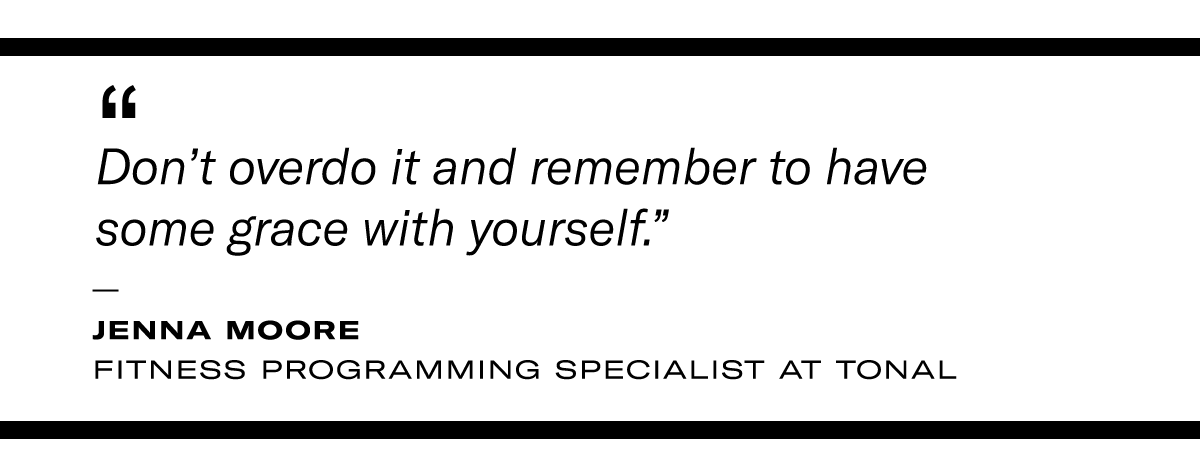Working out after taking a break can feel daunting, but these proven strategies will help you ease back into a routine.

Even the best-laid workout plans can be easily derailed by a nasty cold, pulled muscle, or stressful quarter at work. It’s discouraging to take a step back when you’ve been making steady progress, but you can still come back strong—no matter how much time you’ve taken off.
“Habits can be reestablished after a short period of time,” explains Connor Joyce, an applied behavioral science researcher. “But after a longer period of time, they’re broken, and you actually have to reestablish a good habit.” That’s why it feels challenging to return to exercise even if you had a steady streak going before your break.
It’s also important to ease back into your routine physically. “Don’t overdo it and remember to have some grace with yourself,” adds Jenna Moore, a fitness programming specialist at Tonal. “If you’ve taken longer than two or three weeks off, you could potentially see physiological changes such as loss of muscle mass and endurance.”
Fortunately, there are proven strategies you can utilize to get back on track. Here, Joyce and Moore break down six key steps to make a smooth comeback.

How to Start Exercising Again
Start Fresh
Research by behavioral scientist Katy Milkman, author of How to Change, has demonstrated that you’re more likely to stick with a habit if you begin on a date that signifies a fresh start. One study, co-authored by Milkman, showed that gym visits among college students increased at the start of a week, month, or year, and that more people were likely to commit to a goal during these fresh-start periods. Joyce explains that this could be a significant day like your birthday, New Year’s Day, or even just a Monday that represents the start of a new week.
This may be especially helpful after coming back from time off, as you can see the fresh start as the official end of your break and the beginning of your return to exercise. Joyce says this gives you the opportunity to tell yourself that today is the start of your new routine.
Find Your Why
People who are intrinsically motivated to exercise, or enjoy working out for its own sake, will have an easier time returning to their habits than those who are extrinsically motivated, or driven to workout by external factors, like feedback from others.
If you were intrinsically motivated before taking a break, you’ll get the same reward from exercising once you come back—whether that’s a sense of happiness, relaxation, or relief from stress. Even if it’s hard to get started again, once you experience those feelings after your first workout back, your brain will start reconnecting those positive emotions with your exercise habit and help to reinforce it.
Don’t panic if you fall into that second bucket of extrinsically motivated exercisers, though. You’ll just have to think a little harder about the rewards you did get from working out and try to find them again. Maybe this was the sense of community in a live class or the accountability of a workout challenge with friends. If you recreate those conditions when you return from your break, you’ll have a better chance of reestablishing your habit.

Replace a Bad Habit
“Generally, it is easier to form a new good habit than it is to break an old bad habit,” says Joyce. This is good news if you’ve been going through a stressful time and have gotten in the habit of sitting down in front of the TV after work instead of jumping right into a workout.
Instead of beating yourself up over the bad habit, shift your focus to creating a new good one. Figure out the cue that triggers the behavior you want to change and start associating it with the new action you want to take. So if you typically slip into sweatpants right when you get home from work, commit to putting on your workout clothes instead and using that action as a reminder to exercise. Or if you’ve started hitting snooze on your alarm in the morning, move your clock or phone across the room to force yourself to get moving.
Set Small Goals
When you’re coming back from a break, workouts that seemed easy before might be more challenging. This could be due to a loss of fitness if you were sick or injured, or because the idea of doing your old routine seems intimidating.
“The ideology of starting small and building up is really important,” says Joyce. He cites behavior scientist BJ Fogg, author of Tiny Habits, whose research has shown that the confidence of achieving small goals along the way to bigger ones helps with habit formation.
Joyce explains that these goals should be “realistic, but challenging,” so that you’re able to meet them but still feel a sense of accomplishment when you do. Consider sharing goals with a friend, as challenging each other to achieve them will add a motivating social boost.

Pick The Right Workouts
Set yourself up to hit those small goals by picking appropriate workouts. Now’s not the time to do an advanced-level heavy-lifting session that could leave you injured and set you back yet again. Moore recommends shorter (no more than 30 minutes) full-body workouts that won’t overtax a specific muscle group.
Choose strength workouts with a higher rep count (such as 12 to 15 reps) and lighter weight or ones that don’t prescribe a specific number of reps at all. “Picking a duration-based workout would be your best bet on Tonal because then you can move at your own pace and not worry about having to complete a certain number of repetitions,” says Moore. “It’s just about whatever you feel comfortable and capable of doing in that time period.”
Prioritize Recovery
Now that you’re doing shorter workouts or working out fewer days a week (remember, as Moore says, “less is more when you’re coming back”), you have time to slot in recovery sessions. Pushing too hard after a break puts you at risk of getting hurt, so recovery is especially critical at this time. “Recovery workouts in the off-Tonal modalities, like yoga, barre, and mobility, will help keep your momentum going,” says Moore. “It’s a great time to focus on form and skill development.”
She suggests using the muscle readiness feature on Tonal to see which muscle groups are ready to be challenged again and which ones need rest. “That will certainly help you avoid potential injury as well from overuse.” Once you start lifting heavy again, Moore says it’s a good idea to turn on Spotter mode which will decrease the weight when you’re struggling to preserve your form.


